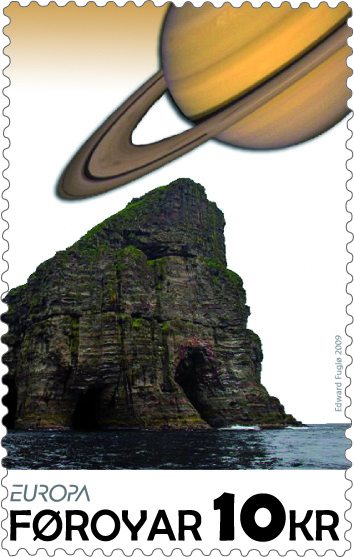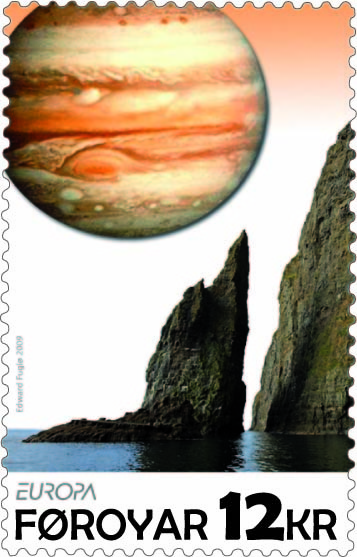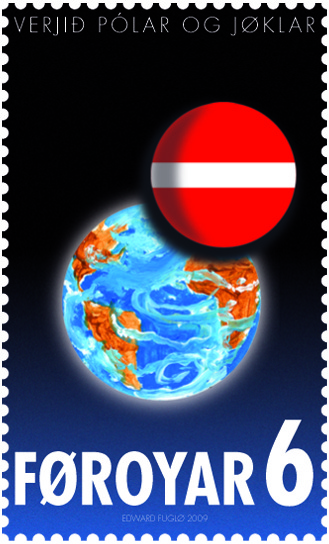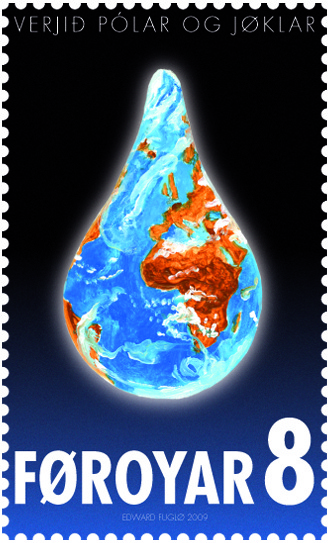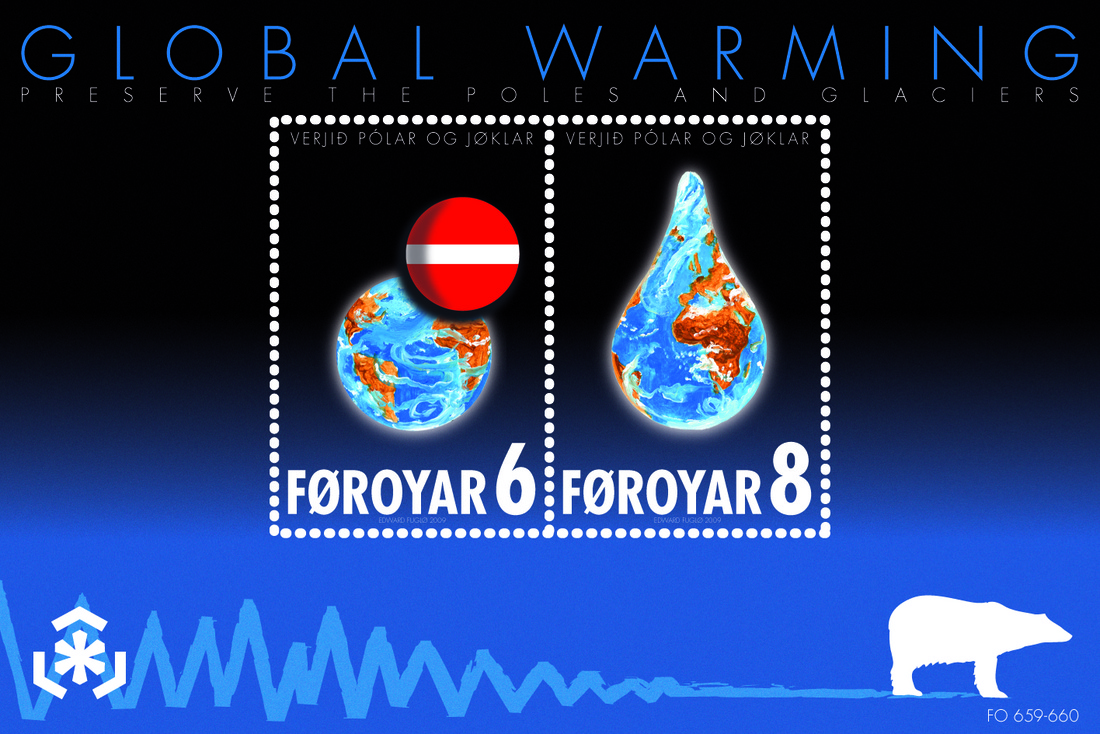2009
Franking labels 2009 - Riddles
Date Of Issue 16/09/2009
Date Of Issue 16/09/2009
Faroese riddles
The first set of Faroese franking labels was issued in October 2008.
The 2009 issue is entitled “Faroese Riddles” and is designed by the Faroese artist, Edward Fuglø. The riddles are:
-Four are hanging down, four walking, two showing the way, and one dangling behind (a cow).
- Bouncing and making noise, carrying human bones in its stomach (a boat).
- Lies in a river, stretches its toe, with more than a hundred holes on it (sock).
- Round like an egg, reaches around the walls of the church (ball of yarn).
Mint and cancelled franking labels can be ordered and first day cancellations or ordinary day cancellations are available. First day covers with all four franking labels, or four envelopes, each with its own franking label are also available.
As a customer and stamp collector you can decide the value of the franking labels. However, the face value cannot be lower than DKK 6.00 or higher than DKK 100.00.
The franking labels are not included in the yearbook or year pack.
The first set of Faroese franking labels was issued in October 2008.
The 2009 issue is entitled “Faroese Riddles” and is designed by the Faroese artist, Edward Fuglø. The riddles are:
-Four are hanging down, four walking, two showing the way, and one dangling behind (a cow).
- Bouncing and making noise, carrying human bones in its stomach (a boat).
- Lies in a river, stretches its toe, with more than a hundred holes on it (sock).
- Round like an egg, reaches around the walls of the church (ball of yarn).
Mint and cancelled franking labels can be ordered and first day cancellations or ordinary day cancellations are available. First day covers with all four franking labels, or four envelopes, each with its own franking label are also available.
As a customer and stamp collector you can decide the value of the franking labels. However, the face value cannot be lower than DKK 6.00 or higher than DKK 100.00.
The franking labels are not included in the yearbook or year pack.
Europa 2009 – Astronomy
Date Of Issue 25.05.2009
Date Of Issue 25.05.2009
Astronomy Anniversary
The United Nations has declared 2009 as the International Year of Astronomy to commemorate when Galileo began to explore space with his homemade telescope 400 years ago.
In 1609, the Italian astronomer and physicist, Galileo Galilei, learned that Hans Lippershey in Holland had performed experiments with a telescope. Galileo immediately began his own experiments with lenses. After a short time, he had built his own telescope. He understood that the telescope could be a useful instrument for exploring space. One November evening in 1609, he saw both deep craters and flat plains on the Moon. On the nights following, he looked at different constellations and discovered that he could see many more stars using his telescope than with the naked eye. He also discovered that the Milky Way was nothing less than a collection of an inconceivable number of stars.
Galileo was born in Pisa on 15 February 1564. He initially studied medicine, but his real interests were mathematics and physics. At the age of just 25, he became Professor of Mathematics in Pisa and from 1591 he taught in Padua. Teaching did not capture his powerful imagination and he yearned to be engaged in pure research. He realised his dream in 1610, when he was employed by his former pupil, Cosimo II de’ Medici, the Grand Duke of Tuscany. Galileo settled in Florence and returned to his former position in Pisa, but without any teaching duties and administrative tasks.
On 7 January 1610, he observed Jupiter through his telescope. He saw three small ‘stars’ close to Jupiter, two on the western side of the planet and one on the eastern side of the planet. At first, he believed them to be fixed stars and he followed these stars on subsequent nights. On 13 January, he wrote in his journal that he could now see a fourth star near Jupiter. On the 14th, the sky was overcast, but on the 15th the skies were clear again and all four stars were now west of the planet. The mystery was now solved: The ‘stars’ were actually moons in orbit around Jupiter. These four moons are now jointly called the Galilean moons. This reinforced Galileo’s Copernican conviction that the Sun was the centre of the solar system. If moons can orbit Jupiter, the Earth and the other planets could also orbit the Sun. Galileo also observed Saturn, but could not distinguish its rings. His telescope was not advanced enough. He drew Saturn as three celestial bodies in a line.
For Galileo, the winter of 1609-10 must have been an incredible time. He saw craters on the Moon, spots on the Sun, the phases of Venus, the moons around Jupiter, and on and on. In March 1610, he published a small book in Latin, Sidereus Nuncius, which outlined his discoveries. The book made him famous throughout Europe within a few weeks time.
In 1632, Galileo published a book in Italian, Dialogo, in which he had three people discuss different world views. This book caused an uproar, and on 22 June 1633 the Inquisition (the Papal court) banished the 69-year-old Galileo to his home, never to leave. The great scientific innovator, who also accomplished a great deal within the field of physics, was therefore a prisoner in his own home near Florence until he died on 8 January 1642. In December of the same year, the scientific genius, Isaac Newton, was born in England. He would eventually discover and formulate the law of universal gravitation, which explains why the Earth orbits around the Sun. In 1992, Pope John Paul II admitted to the injustices perpetrated against Galileo by the Catholic Church.
Pól Jespersen
The United Nations has declared 2009 as the International Year of Astronomy to commemorate when Galileo began to explore space with his homemade telescope 400 years ago.
In 1609, the Italian astronomer and physicist, Galileo Galilei, learned that Hans Lippershey in Holland had performed experiments with a telescope. Galileo immediately began his own experiments with lenses. After a short time, he had built his own telescope. He understood that the telescope could be a useful instrument for exploring space. One November evening in 1609, he saw both deep craters and flat plains on the Moon. On the nights following, he looked at different constellations and discovered that he could see many more stars using his telescope than with the naked eye. He also discovered that the Milky Way was nothing less than a collection of an inconceivable number of stars.
Galileo was born in Pisa on 15 February 1564. He initially studied medicine, but his real interests were mathematics and physics. At the age of just 25, he became Professor of Mathematics in Pisa and from 1591 he taught in Padua. Teaching did not capture his powerful imagination and he yearned to be engaged in pure research. He realised his dream in 1610, when he was employed by his former pupil, Cosimo II de’ Medici, the Grand Duke of Tuscany. Galileo settled in Florence and returned to his former position in Pisa, but without any teaching duties and administrative tasks.
On 7 January 1610, he observed Jupiter through his telescope. He saw three small ‘stars’ close to Jupiter, two on the western side of the planet and one on the eastern side of the planet. At first, he believed them to be fixed stars and he followed these stars on subsequent nights. On 13 January, he wrote in his journal that he could now see a fourth star near Jupiter. On the 14th, the sky was overcast, but on the 15th the skies were clear again and all four stars were now west of the planet. The mystery was now solved: The ‘stars’ were actually moons in orbit around Jupiter. These four moons are now jointly called the Galilean moons. This reinforced Galileo’s Copernican conviction that the Sun was the centre of the solar system. If moons can orbit Jupiter, the Earth and the other planets could also orbit the Sun. Galileo also observed Saturn, but could not distinguish its rings. His telescope was not advanced enough. He drew Saturn as three celestial bodies in a line.
For Galileo, the winter of 1609-10 must have been an incredible time. He saw craters on the Moon, spots on the Sun, the phases of Venus, the moons around Jupiter, and on and on. In March 1610, he published a small book in Latin, Sidereus Nuncius, which outlined his discoveries. The book made him famous throughout Europe within a few weeks time.
In 1632, Galileo published a book in Italian, Dialogo, in which he had three people discuss different world views. This book caused an uproar, and on 22 June 1633 the Inquisition (the Papal court) banished the 69-year-old Galileo to his home, never to leave. The great scientific innovator, who also accomplished a great deal within the field of physics, was therefore a prisoner in his own home near Florence until he died on 8 January 1642. In December of the same year, the scientific genius, Isaac Newton, was born in England. He would eventually discover and formulate the law of universal gravitation, which explains why the Earth orbits around the Sun. In 1992, Pope John Paul II admitted to the injustices perpetrated against Galileo by the Catholic Church.
Pól Jespersen
Global Warming
Date Of Issue 23.02.2009
Date Of Issue 23.02.2009
The earth’s climate is changing and this is caused by mankind. Although some regions may cool for a time, the earth as a whole is getting steadily warmer and this will continue during this century. Other climate changes follow the warming. Sea level is increasing. There will be more drought in some areas e.g., in parts of Africa where people, already now, are suffering from water shortage. And the extra water that evaporates from Africa and similar locations will fall down as increased precipitation elsewhere, such as at our latitudes.
These changes occur because we humans are emitting various substances into the atmosphere that change the climate. Especially carbon dioxide, CO2, is important. This substance is emitted whenever we burn oil, coal, or gas in cars, factories, for heating our homes, etc. The bad thing about CO2 is that it acts somewhat like the insulation in a house. When we increase the insulation of our house, it becomes warmer, and this is what we are now doing to the earth.
It is hard to predict, how large the changes will become, since we don’t know how much CO2 will be emitted in the future. In the worst case, the earth may warm some 6 degrees centigrade during this century. This is more than the temperature increase since the last ice-age. Added to this, are the other climate changes. This will have large impacts on living organisms on land and in the sea: plants, animals, and humans. It is hard to predict exactly, what changes will occur, but the damages are expected to increase with increasing climate change.
Different regions may well be affected in different ways and may also be most sensitive to different aspects of climate change: In some places, heat-waves, elsewhere drought, or floods, or the sea flooding the land. The Arctic is one region that has been predicted to change more than most and it seems that even some of these predictions may be underestimates.
The Faroe Islands are located on the boundary of the Arctic but the climate is also very dependent on the heat carried by the ocean currents. If they were to change, the boundary could move. At the present, it is therefore very difficult to predict, how the Faroese climate will change. Almost certainly, there will, however, be changes and they will affect the living conditions and the resources, such as fish, that the Faroese depend on.
Global warming cannot be immediately stopped. We have perturbed the climate balance and it needs time to re-adjust. A car does not stop immediately after you step on the brake, and neither does the climate. To prevent dangerous consequences, it is essential to put the brakes on well before the danger signals are evident. We can reduce the long-term consequences of global warming by limiting the increases in CO2 emission, but this requires politicians that are sufficiently smart and responsible to plan farther ahead than to the next election.
Bogi Hansen
These changes occur because we humans are emitting various substances into the atmosphere that change the climate. Especially carbon dioxide, CO2, is important. This substance is emitted whenever we burn oil, coal, or gas in cars, factories, for heating our homes, etc. The bad thing about CO2 is that it acts somewhat like the insulation in a house. When we increase the insulation of our house, it becomes warmer, and this is what we are now doing to the earth.
It is hard to predict, how large the changes will become, since we don’t know how much CO2 will be emitted in the future. In the worst case, the earth may warm some 6 degrees centigrade during this century. This is more than the temperature increase since the last ice-age. Added to this, are the other climate changes. This will have large impacts on living organisms on land and in the sea: plants, animals, and humans. It is hard to predict exactly, what changes will occur, but the damages are expected to increase with increasing climate change.
Different regions may well be affected in different ways and may also be most sensitive to different aspects of climate change: In some places, heat-waves, elsewhere drought, or floods, or the sea flooding the land. The Arctic is one region that has been predicted to change more than most and it seems that even some of these predictions may be underestimates.
The Faroe Islands are located on the boundary of the Arctic but the climate is also very dependent on the heat carried by the ocean currents. If they were to change, the boundary could move. At the present, it is therefore very difficult to predict, how the Faroese climate will change. Almost certainly, there will, however, be changes and they will affect the living conditions and the resources, such as fish, that the Faroese depend on.
Global warming cannot be immediately stopped. We have perturbed the climate balance and it needs time to re-adjust. A car does not stop immediately after you step on the brake, and neither does the climate. To prevent dangerous consequences, it is essential to put the brakes on well before the danger signals are evident. We can reduce the long-term consequences of global warming by limiting the increases in CO2 emission, but this requires politicians that are sufficiently smart and responsible to plan farther ahead than to the next election.
Bogi Hansen
All Issues Copyright Posta, www.stamps.fo


